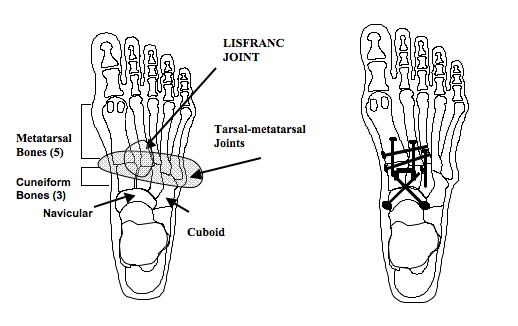Midfoot arthritis can cause disabling pain, and it can develop for a number of reasons, but the most common is the result of trauma to the foot in the form of a fracture, sprain, or dislocations. Bunion deformities, rupture of the plantar fascia, and tight heel cords increase the stress at the midfoot and may also cause arthritis. Pain, swelling, and deformities are common this condition. When non-operative treatment like shoe wear modifications and injections fail, a midfoot arthrodesis procedure is indicated.
Are you experiencing pain, discomfort or swelling in the middle of your foot?
If so, let Dr. Silverman help.
For more information about Midfoot arthritis surgery, keep reading.
What Happens Before Midfoot Arthrodesis Surgery?
The surgical center will provide specific instructions for how you can prepare for surgery and what to expect when you arrive at the clinic. The day of surgery you will receive regional anesthesia known as a popliteal nerve block. This is a procedure performed by the anesthesiologist prior to surgery. You will be placed on your stomach and a small needle is used to inject Novocain-like medication around the nerve in your leg. It gives complete pain relief that lasts for 12 to 36 hours. Patients report extraordinary satisfaction with this type of anesthesia. You will be given antibiotics just before surgery to help prevent infection.

What Happens During Midfoot Arthrodesis Surgery?
During surgery you will be put into a relaxed state by the medication delivered through the I.V. A tourniquet will be placed around your calf. You will not feel the pressure because of the nerve block. Incisions will be made along the inside and outside of your foot, inside of the ankle, and back of the leg. The foot is repositioned to fuse the bones in correct alignment. A variety of instrumentation may by used to hold the bones and joints in place while they mend including screws, plates, wires, and staples. Bone grafting and heel cord lengthening maybe required. X-Rays taken during the surgery confirm the correction. The wounds are closed with stitches and staples.
What Happens After Midfoot Arthrodesis Surgery?
You will be permitted to leave the surgical center once your anesthesiologist is satisfied that you have recovered. Depending on your needs you will be admitted to the hospital for a short stay or discharged home. If you are having outpatient surgery your family member should take your prescription to the nearest pharmacy while you recover. You will be in a sterile protective splint. You will also be given crutches. Take your narcotic pain control medications before falling asleep or as you feel the “numbing” effect wearing off. Remember, post operative pain is much easier to control with prevention.
Midfoot Arthrodesis General Recovery Timeline
This timeline is a general guideline. Your post-operative course may vary.
| Elevation | Elevation 23 hours / day for 10 days; swelling may last over 4 months. |
| Motion | Move your toes and knee when the block resolves. This will decrease pain, swelling and improve healing. |
| Walking | If you are healing well, begin heel weight bearing at 6 weeks in a fracture brace when you have permission. |
| Bathing | Keep cast dry. Use a Xerosox. There are no restrictions after the cast is removed. |
| Dressing | Apply a Pedifix Compression Sleeve after cast removed. |
| Pain Control | Expect to use strong narcotics for the first 3-5 days. Wean off as soon as you are comfortable using Tylenol or Ultram (Rx only). NSAIDS will slow healing. |
| Work | Return depends on specific demands. It is safe to return to sedentary work at 10 days post-op. Return to heavy labor will take at least 3 months. |
| Driving | Patients with left foot surgery may drive an automatic transmission. Patients with right foot surgery must wait until healing is adequate and they feel safe. |
Routine Clinic Visits
| 2 weeks | X-rays. Cast and staple removal. |
| 6 weeks | X-rays. Earliest time of bone healing to permit weight bearing activity and to place in a fracture brace. The time to return for your next visit varies significantly. |
| 14 weeks | X-rays. Return to check on healing. |
| 4-6 months | Return for recheck; Strength improves over then next year. Minimal feelings of discomfort may linger, your overall comfort level improves over a year. |
| ********** | If at any time during your post-operative period you notice any drainage or foul odor from your incision, a temperature of more than 100.4 degrees and/or increased swelling or tenderness, you should contact our office. |
For more helpful tips, check out these rehab exercise videos that will help you recover, or reach out to Dr. Silverman for more information!